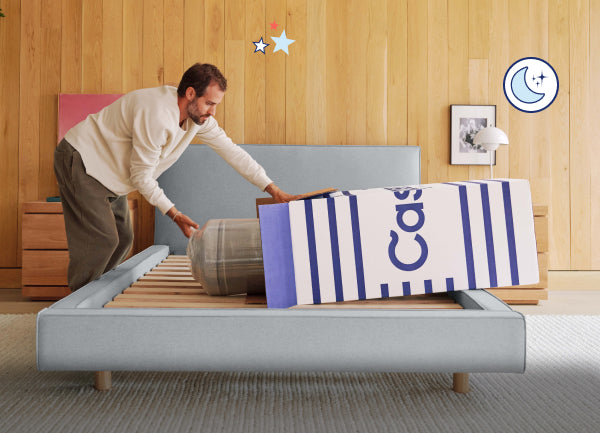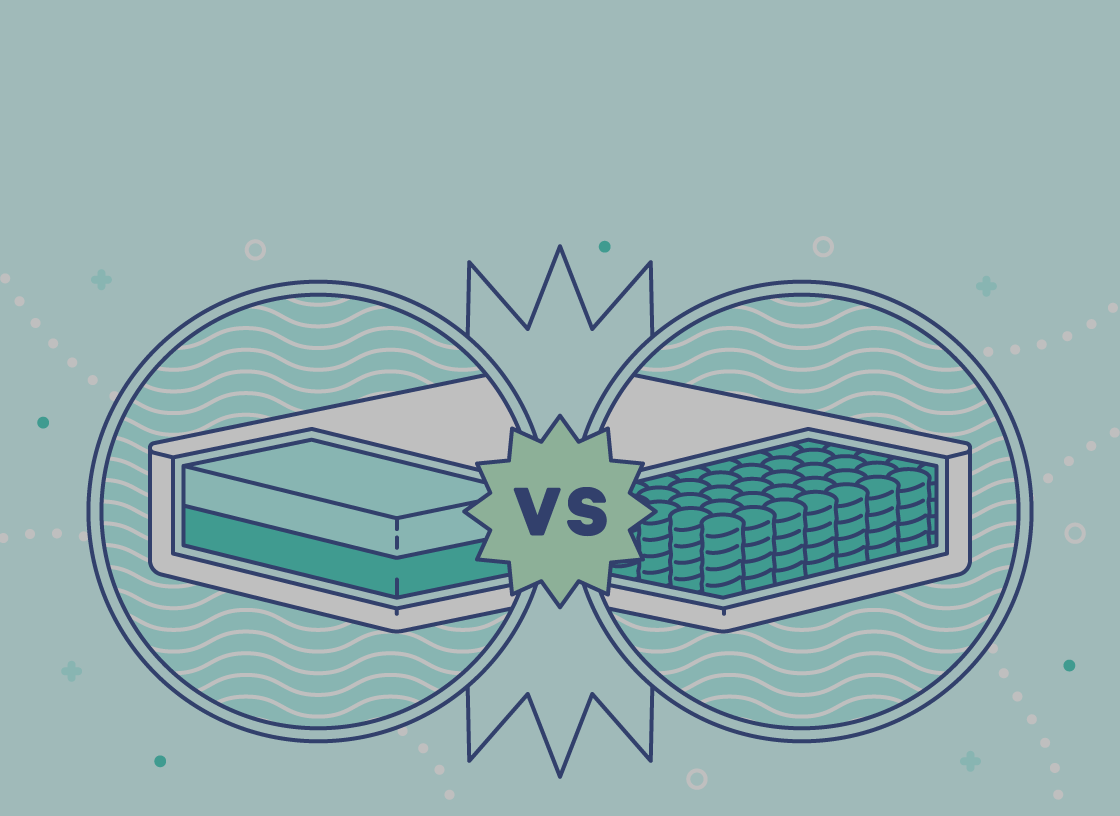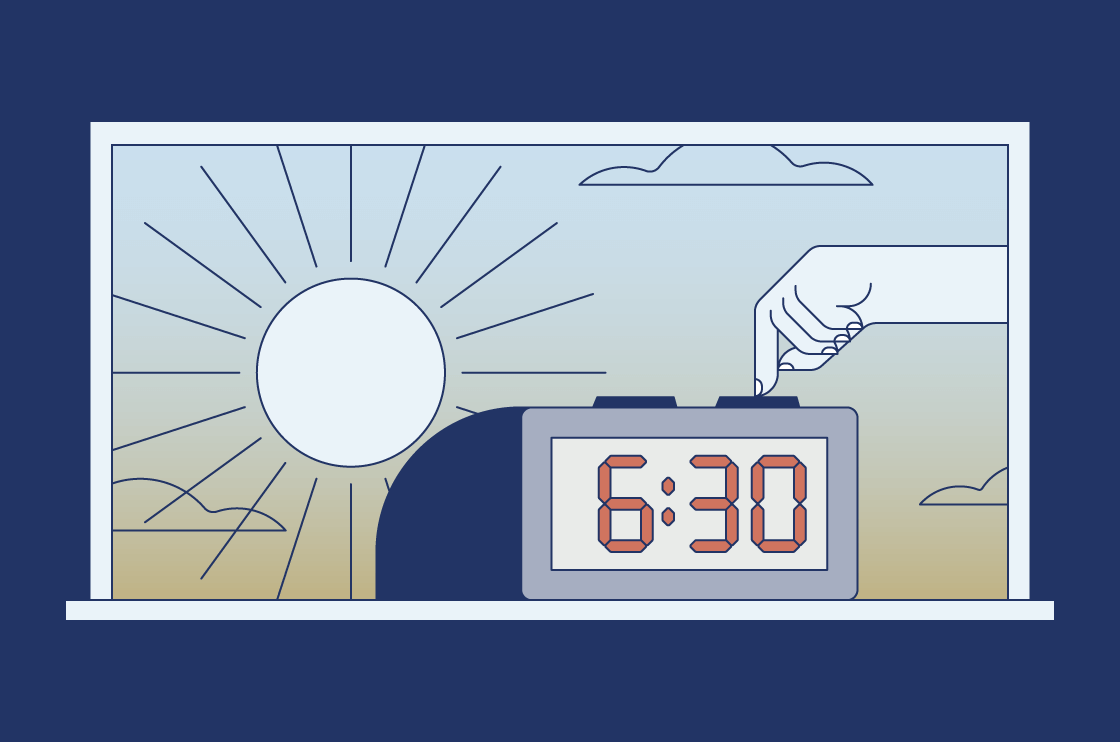A mattress without a bed frame is like a pie without its crust: in the absence of that beautifully built golden layer, it loses its support, stability, and foundation—not to mention its style.
It’s easy to imagine, then, why choosing a well-made bed frame with a proper mattress foundation is an important part of getting a good night’s rest. But if you’ve only just begun your search, the options can be overwhelming.
If you’re wondering how to choose a bed frame, read on.
Whether you need a full or queen size, or an upholstered or wood bed frame, Casper has a wide variety of beds available to choose from.
In this guide, we’ll walk you through everything you need to know about finding the right frame, from deciding on your budget and size to navigating all the types of beds available. So, let’s get started.
Step 1: Determine How Much You’re Willing to Spend
Setting a budget is an easy way to instantly narrow your bed frame search. With huge ranges in price, bed frames can cost anywhere from under $100 to over $2000.
Given the number of cheaper options available, it may be tempting to choose the lowest-priced bed frame you can find, especially if you’ve already splurged in the mattress department.
Yet, it’s important to consider your options carefully and understand what quality you’re getting for the cost. After all, sleep is stupendously important to our overall well-being, affecting innumerable aspects of our physical and mental health.1 With so much on the line, you want to make sure to get the best available option for what you can afford.
So, how do you know if a bed frame is worth the cost? Here are a few things to look for:

- Construction – How is the bed frame put together? Will you have to assemble it yourself, and if so, how difficult will it be? Will it require any special tools?
- Material – Is it made of sturdy, durable materials? For longevity’s sake, it’s best to find a frame made primarily of longer-lasting options, like a solid wood bed frame and metal bed frame, rather than wood composites or plastics. The former options are less likely to break and will stand up to more wear and tear over time.
- Stability – Does the bed frame have plenty of traction and support where it rests on the ground? Ideally, you want a bed frame that won’t creak or move from side to side when pushed or leaned against and doesn’t need additional support to stay in place.
- Support – Does the bed frame provide enough support for your mattress, from top to bottom? Are there extra supports underneath the bed to stabilize the center? Remember the idea of a pie crust: Without adequate support, your mattress could sag or lose its shape over time.
- Headboard – You’ll also want to decide if you need a headboard. A headboard can provide extra back and neck support, prevent wall damage, and elevate your room’s decor. But it’s not a necessity — forgoing a headboard will save you a little wall and floor space. Some bed frames come with the headboard attached, while others support detachable headboards.
With these considerations in mind, you’ll be able to choose a bed frame that suits both your budget and your taste—all while steering clear of options whose promises of excellent sleep aren’t supported by quality construction.

Step 2: Decide What Size You Need
Choosing the right size bed frame is crucial if you’ve already purchased a mattress. Though some sizes can seem similar, there are differences in measurements for each of the most common mattress sizes, so you’ll need a bed frame to match.
If you’re in the market for a new mattress, however, you have a lot more flexibility when it comes to choosing your bed frame. In this case, you may want to consider the size of the room the bed will be in and how much space you need around it.
Let’s take a look at the different bed sizes, and what they have to offer:
- Twin – The smallest option available, a twin bed can accommodate a single child or adult and fits well in the smallest of rooms. A twin bed frame typically measures 38” x 75”.2
- Twin XL – For those who need a single bed with a little extra length, a twin XL is a slightly extended version of a regular twin, measuring five inches longer at 38” x 80”.
- Full/Double – A full-sized bed, also known as a double, can comfortably fit a single adult at 54” x 75”. Though it may feel a bit small for two adults, it can accommodate two people if needed and can still be a good option for smaller and medium-sized bedrooms.
- Queen – Measuring at 60” x 80”, a queen-sized bed is arguably the most common option for two adults, providing plenty of room without taking up an excessive amount of space. Because of the increased size, a queen is likely to fit the best in a medium-sized room or larger.
- King – At 76” x 80”, a king-sized bed boasts an additional sixteen inches compared to a queen and is the widest standard bed size available. A king takes up considerably more space and is thus suited to a larger room.
- California King – Though not quite as wide as a regular king, the California king memory foam mattress offers four extra inches in length for those who need more room to stretch out, measuring at 72” x 84”.
One helpful tip when choosing your future mattress and bed frame is to consider the size of your current bed and how it suits your home, needs, and lifestyle. If you need extra room for pets or children, for example, sizing up may be a good idea. If, however, you’d like to make more use of the space around your bed, choosing a reasonably-sized mattress and frame will be of the most importance.
Your room size can also help you narrow down what type of bed frame to get. For example, a large primary bedroom may serve canopy or sleigh bed frames well. If you’re shopping for a small bedroom, you may want to consider a platform bed to save space.
Try to keep at least two feet free on each side of the bed so you can move around it.

Step 3: Choose a Bed Height Preference
Another aspect related to the size of your bed frame is its height. While many bed frames are situated at about the height of your knees, certain aspects of your life may impact what bed height is most suitable for you.
If you have restricted mobility, for example, it’ll be important to choose a bed frame that’s easy to climb into and out of, like Casper’s Upholstered Bed Frame, which sits at only 10.6 inches off the ground. This is also something to consider if the bed will be shared with pets or little ones.
An easy test of ideal bed frame height is to sit in a chair where your feet comfortably rest on the ground and then measure the height of the chair’s seat. If the combined height of your bed frame and mattress is too much taller, it could pose difficulty at bedtime.
On the other hand, if you like your bed a little higher off the ground, you may have the benefit of using the area underneath for additional storage space—a great advantage for those inhabiting smaller rooms.
Step 4: Determine Whether You’ll Need a Box Spring
As you traverse the world of bed frames and unravel the mysteries of how to buy a bed, you may be wondering do you need a box spring. If you already have one at home and plan to use it with your existing mattress, you’ll want to make sure to find a bed frame that can accommodate both.
If you don’t already own a box spring, though, you may be happy to learn that, when paired with a contemporary mattress, many modern bed frames simply don’t need them. (Can you imagine if that pie we mentioned didn’t need a pie pan? Pure magic.)
Instead, you can look for wooden bed frames with a mattress foundation or platform that still provides plenty of support, like the Casper Mattress Foundation.
The solid wood engineering of the Casper Mattress Foundation ensures both support and durability, while providing the height of a traditional box spring.

Step 5: Consider Your Current Bedroom Aesthetic
Once you’ve narrowed down the criteria for your bed frame search, you’ll want to consider what bed frame style suits your current sleeping space. If your aesthetic is cozy and traditional, for example, you might want a more traditional bed frame with:
- Wood accents – Like the Casper Repose
- A soft, upholstered headboard – Like the Casper Haven
If you like a bed frame style that is more sleek and modern, you might prefer the smooth lines of a metal frame or the minimalistic look of a platform bed frame.
In either case, jotting down a general idea of what you hope to find will help you keep your eyes on the prize: finding the right bed frame that suits all of your needs, including your aesthetic.
Step 6: Browse Different Types of Frames
After determining what size, height, and style of bed frame you need, you’ll now want to look at the different types available. If this seems like another category with too many options, don’t fret: all the work you’ve done so far will help narrow it down.
The best way to begin is by seeing which bed frames match your criteria of size and style. At Casper, we offer bed frames to suit every need, aesthetic, and lifestyle, including:
-
The Wooden Bed Frame – Crafted for quality with premium materials and sustainably sourced wood. Softened edges add an inviting look.
-
The Upholstered Bed Frame – Provides silent, sturdy support with a cozy, fabric-wrapped appearance.
-
The Platform Bed Frame – A thick, sturdy base typically low to the ground that provides optimal support for your mattress..
-
The Adjustable Bed Frame – A remote-controlled bed frame that can transform into several different pressure-relieving positions.
- The Foundation + Metal Bed Frame – A durable, modern bed frame design with a simple look.
Whether you’re setting out on your own for the first time or looking for a well-earned upgrade, our frames will help ensure your bed looks as good as it feels.
Common Bed Frames Compared
Next, we’ll go through several common bed frames and weigh their pros and cons.
Platform Bed Frame
A platform bed frame is a modern and minimal yet sturdy base for your mattress. The major benefit of a platform bed frame is that you don’t need a box spring — you can place your mattress directly on top of the frame (and most mattresses are compatible).

Pros:
- Doesn’t require a box spring or foundation
- Sleek and minimalist design
Cons:
- Can feel too low to the ground for some
Metal
Metal bed frames are durable and solid. They come in a variety of styles — from basic to ornate. Stainless steel and brass are common materials for metal bed frames. They are supportive and can hold a heavier mattress with no problem.
Pros
- Sturdy, holds a lot of weight
- Easy to clean and maintain
Cons
- Can be heavy and hard to move
Adjustable
Adjustable bed frames are controlled with a remote to adjust into different positions by raising and lowering the head and foot of the bed. This is a great option for those with mobility issues or those who experience pain when they sleep and need to change their position throughout the night. You’ll just need to get a compatible mattress for your adjustable bed frame.

Pros
- Can adjust bed head and foot for maximum comfort
Cons
- On the more expensive side
Four-Poster or Canopy
Four-poster bed frames have long posts rising up from each corner. This is a popular style in large primary bedrooms, where the bed can take up a lot of space. They often have a grand, regal look.
Although similar to four-poster frames, canopy bed frames have four posters that connect and form a frame at the top. For a traditional or whimsical look, you can drape fabric over the canopy frame to create curtains around the bed.
Pros
- Makes a grand statement in a large room
- Great for a traditional look
Cons
- Large and hard to move
- Need tall ceilings to fit
Bunk Bed
Bunk beds are fun, space-saving options for kids’ rooms — with one bed that stacks above another as part of a single unit. A ladder allows you to climb up and down from the top bunk.
Pros
- Saves space in a room
- Fun for kids, siblings, guests, and sleepovers
Cons
- Large and hard to move
- Have to climb in and out of bed
Upholstered
Upholstered bed frames are wrapped in fabric to give a soft and cozy look. They come in many different types of fabric, including suede, faux leather, and velvet. They range in style from simple, streamlined looks to more decorative designs with button studs and embroidery.

Pros
- Comfortable and soft
- Many different types of fabric available
Cons
- You’ll need to vacuum to keep it clean
- Some are not as durable as wood or metal
Wrought-Iron
Wrought-iron bed frames are sturdy and long-lasting. They often feature ornate designs on both the footboard and headboard, adding to a traditional and elegant look in the bedroom.
Pros
- Durable and can hold significant weight
- Ornate and decorative
Cons
- Can be more expensive
Storage
Storage bed frames include built-in storage elements such as cabinets, drawers, and shelves. These take up more space but provide excellent storage nooks for books, clothing, and other belongings.
Pros
- Lots of extra storage space
Cons
- Bulky and hard to move
- Can be more expensive
Wood
There are different types of wooden bed frames, many of which have a soft, traditional look. These are sometimes large and heavy, but they are also very sturdy. Because they come in all different types of wood and range from bare to decorative, it’s easy to find a wooden bed frame that matches your existing furniture.
Pros
- Easy to match with existing decor
- Wide range of styles available
Cons
- Can be heavy and hard to move
Bed Frame FAQs
Bed frames range widely in price depending on the material, size, and style. Simple metal frames will be the cheapest option, starting at around $100. Wooden, upholstered, and adjustable frames range higher in price, from around $500 to over $2,000. It all depends on what style and level of quality are most important to you.
Yes, the bed frame is the framework that gives your bed its stability and support. It also lifts up your mattress to a comfortable height and allows you to get in and out of bed more easily. A bed frame protects and extends the life of your mattress by keeping it off the floor as well.
Note the size and dimensions of your mattress to find a bed frame that will fit. Different companies use different dimensions for their mattresses, so it’s always best to double-check. It’s a safe bet to buy your mattress and bed frame from the same company to ensure you’re getting a matching pair.
A platform bed frame doesn’t need a box spring. You can place the mattress directly on the platform bed frame, or, if you want extra height, you can put both a foundation and your mattress on the platform bed frame.
Casper: Good Sleep from the Ground Up
Choosing the right bed frame may not be as easy as pie, but at Casper, we’re determined to help you get that delicious sleep you’ve been searching for.
Our range of bed frames can fit any budget while checking off your boxes for size, bed height, and style. Plus, no matter which you choose, you’re guaranteed to get supportive sleep. Find your perfect bed frame and your perfect night’s rest, with Casper.
Sources:
- Pharmacy and Therapeutics. The Extraordinary Importance of Sleep.
- https://www.ncbi.nlm.nih.gov/pmc/articles/PMC6281147/
- Sleep Foundation. Bed Frame Sizes. https://www.sleepfoundation.org/bed-frame-sizes














